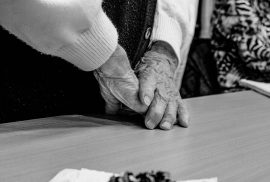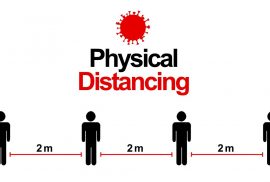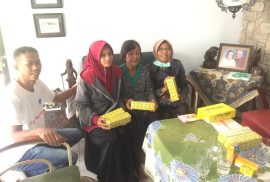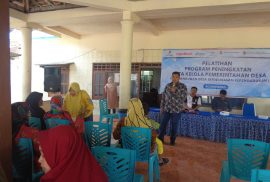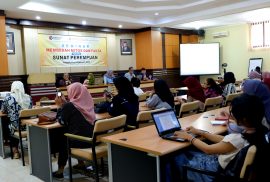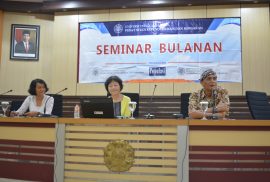Yogyakarta – Center for Population and Policy Studies (CPPS) UGM in collaboration with The National Team for the Acceleration of Poverty Reduction (TNP2K) held an online seminar “Vulnerable Groups and COVID-19 in Indonesia” on Wednesday, July 27, 2020 at 9.30-12 a.m.
The Indonesia Statistics Agency recorded the poverty rate as of March 2020 increased to 26.42 million people. Regarding this position, the percentage of poor people also rose to 9.78 percent as of March 2020.
The increase in poverty rate reached 1.28 million people from the previous rate, 25.14 million people compared to the rate as of March 2019. The percentage of poor people also rose 0.37 percent from March 2019, which was only 9.41 percent.
This is in line with the statement of the head of Yogyakarta Development Planning Agency, Budi Wibowo, when he stood as a speaker at the CPPS UGM seminar on Thursday (29/07/2020). He said that the poverty rate in Yogyakarta during the COVID-19 pandemic has increased. The increase as of March 2020 reached 12.28 percent, rose 0.84 percent from September 2019 (i.e. 11.44 percent).
According to him, the regional government should make several efforts to overcome this economic problem, such as refocusing and reallocating the local budget, e.g. accelerating changes in the allocation of the local budget, stopping the entire process of procurement of goods or services that do not yet have a contract as of 3 April 2020, except for the operation of Regional Apparatus Organization, goods sourced from privileged funds, and the operation and maintenance of basic or public services.
“We (the local government) have opened several tourist destinations and we will try even more tightly to implement them in the tourist destinations because there are thousands of MSMEs behind those tourist destinations. Fifty-one thousand MSMEs in Yogyakarta are engineering goods for economic growth,” he emphasized.
Responding to the economic problems during COVID-19, the head of CPPS UGM, Agus Joko Pitoyo stressed the impact of COVID-19 on the informal sector. He explained that the informal sector is important to discuss since it dominates the workforce structure in Indonesia.
“More than 70 million workers work in the informal sector. There are high number of workers working in this sector because it tends to be more easily obtained by the workforce,” he said.
The informal sector during the COVID-19 pandemic also tends not to be sustainable. This is at least marked from the disruption of production, distribution, and consumption to a decrease in income. The downturn is also due to restrictions on social activities that cause disruption to economic activities (production, distribution, and consumption) and product supply chain.
The Indonesia Statistics Agency data shows that 70.53 percent of the respondents from the low-income group (<1.8 million) stated that they experienced an income decrease. Meanwhile, the COVID-19 pandemic also caused an increase in spending for 56 percent of respondents, most of them experienced an increase of between 26-50 percent. Most of the increase occurred in food expenditure (51 percent) and this is possible due to the existence of Work from Home (WFH) and Study from Home (SFH).
Survey of CPPS UGM: The Impacts on Informal Workers
Agus Joko Pitoyo delivered the results of the initial survey of CPPS UGM related to the impacts of COVID-19 on informal workers. The survey was attended by 64 informal workers in Yogyakarta and conducted in early July and was still going on until this seminar was held. The participating respondents consist of traders, street workers, building construction workers, online transportation drivers, and artists. The results of this survey show that COVID-19 has impacts on income decline, job loss, consumer decline, and business closure.
The results indicate that 31.3 percent of the respondents stated that they began to feel the impact of the pandemic since early April 2020. This goes after the implementation of social restrictions by the government.
However, the decrease in income and the difficulties during the pandemic did not encourage most informal workers to switch their professions due to the low competency and the perception that there are no professions that can offer better conditions. 23.4 percent of the informal workers who change their professions tended to switch to online business ventures. Even poor working conditions due to COVID-19 did not trigger the desire for 46.9 percent of respondents to change their professions during the COVID-19 pandemic. Meanwhile, 35 percent are still wavering over conditions in the midst of COVID-19 pandemic on the professions they currently own. Another 17 percent have the desire to switch their professions.
Also, according to Joko, COVID-19 also affected street workers in the city of Yogyakarta. The majority of workers and street workers experienced a decrease in income to > 50 percent due to social restrictions and schools and office closure.
“There are differences in the impacts of COVID-19 on workers and street vendors. In workers, COVID-19 causes a decrease in working hours and even layoffs. However, during COVID-19, the number of working hours in street workers had increased by 2-3 hours due to waiting for customers and to maintain the revenue,” Joko explained.
“The informal sector has the potentials to have a faster recovery if the community activities are reopened, but still performed on a small scale of recovery. It needs special treatment, for example using economic stimulus, so the recovery process can optimally run,” he concluded.
The coordinator of TNP2K’s social protection policy, Dyah Larasati, highlighted another vulnerable group affected during COVID-19, i.e. people with disabilities. It is estimated that 15 percent of the world’s population has a disability. One in five women will experience a disability condition in their lifetime and one in 10 children have disabilities. Meanwhile, around nine percent (23.3 million people) in Indonesia have disabilities.
“Disability and poverty in Indonesia have a strong correlation. The risk will be greater for disability groups during a pandemic. If we consider the additional costs required by people with disabilities, the poverty rate will significantly increase,” she said.
She conveyed that the COVID-19 pandemic has increased risks and vulnerabilities directly or indirectly in people with disabilities, such as 1) The increase in limited mobility due to “stay at home” policy, either on recommendation or mandate or obligation and it caused the difficulties in accessing basic services, such as health and education services; 2) Limited or difficult access to information and health service facilities, social protection, and other related services; 3) The possibility of reduced or limited income support from other family members because they may also be affected by this pandemic; 4) The increase in social exclusion and isolation which can lead to depression, fear, and helplessness, especially because the people with disabilities and the elderly have a higher possibility of vulnerable medical conditions or congenital diseases, making them more susceptible to these diseases; and 5) Less than three percent of people with disabilities received social assistance through the ASPD and PKH Programs. Limited access to social protection makes them more vulnerable to survive.
Although the risks and vulnerabilities of people with disabilities due to the pandemic are numerous, studies, or data related to the increased vulnerability of people with disabilities during the pandemic are very limited.
“Data and evidence related to increased risk due to the COVID-19 pandemic are very limited to date and can only be found in high-income countries (HICs). Data from low and middle-income countries (Low and Middle-Income Countries/LMICs) is very limited,” she emphasized.
The Study on the Economic Impact of COVID-19 on People with Disabilities in Indonesia by Jaringan Organisasi Penyandang Disabilities (Network of People with Disabilities Organization) on April 2020 showed that 87 percent of workers experience a decrease in income and most of them experience a drastic decline (50-80 percent of income).
The economic vulnerability of people with disabilities during the COVID-19 pandemic is also high. 69 percent of the respondents are likely to be poorer or getting poorer due to a combination of low income and a high decrease in income due to the pandemic. 41 percent of them (very vulnerable) is almost certainly below the poverty line and 28 percent (vulnerable) are below or very close to the poverty line.
To help solving this problem, Dyah suggested the policymakers expand the scope and ensure the appropriateness of the value of social protection benefits, ensure inclusive, comprehensive and integrated social protection, and create a simple registration process.
COVID-19 and Women Marginalization
Senior researcher and gender expert at CPPS UGM, Dewi Haryani Susilastuti, highlighted the marginalization of women in the midst of COVID-19. Annual Records Infographic of the National Commission on Violence against Women 2020 show that there are 14,719 cases of violence against women according to their domains; the personal sphere of 75.4 percent (11,105 cases), the community sphere of 24.4 percent (3,602 cases), and the state sphere of 0.08 percent (12 cases). The highest one is physical violence which reaches 5,548 cases with 4,783 happen in the personal domain and 765 cases happen in the community domain.
“The violence against women tends to increase during the pandemic, but the increase in the level of violence against women is not solely due to the pandemic because it has already existed before,” she said.
Responding to the issue of the impact of COVID-19 on the informal sector, she presented data from the Ministry of Women’s Empowerment and Child Protection and Statistics Agency 2018 which showed that 61.37 percent of women work in the informal sector, while 23.31 percent are family workers.
Besides, there is a marginalization in women during the pandemic due to several factors, such as a lack of critical understanding of the development of gender construction in Indonesia and state ibuism. “We can see what happened in the history during the Suharto’s government, there was something called state ibuism, the state definition or state construction of the ideal woman. Based on state ibuism, the ideal woman is one who is domesticated and highly dedicated to her husband, family, and country. That’s why they sacrifice their lives for the sake of their husband, family, and country without expecting anything personal,” she explained.
According to her, after the Suharto’s government, there was indeed a change of mind towards women, but it cannot be denied that the state ibuism was reproduced in a relatively young society even in the order of policymakers, so the different effects of COVID-19 for men and women are not considered the problem has already been in line with the existing gender construction.
She conveyed that the issue of marginalized women during the pandemic is also due to the lack of representation of social science thinking in responding to the pandemic. “The COVID-19 pandemic is seen more from a health perspective. We can see it at journals, especially those written in the field of health, there are two repeated terms, Pharmaceutical Intervention (vaccine) and Non-Pharmaceutical Intervention. Meanwhile, there is no reflective cultural discussion about context, about structural inequality,” she highlighted.
She concluded that the COVID-19 pandemic has exposed structural inequalities that place women in unfavorable economic, social, and political positions, while the government’s insensitive responses to gender have made the position of women worse off. “If we use the language of war, women are then like collateral damage in the fight against COVID-19,” she concluded.
Writer: Nuraini Ika | Language Editor: Rinta Alvionita | Photo: Alexs_foto (pixabay.com)
Note: The full recording of the seminar can be watched on the CPPS UGM and TNP2K YouTube channel.


